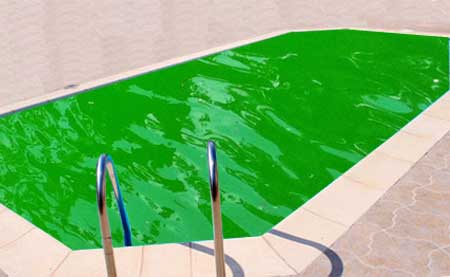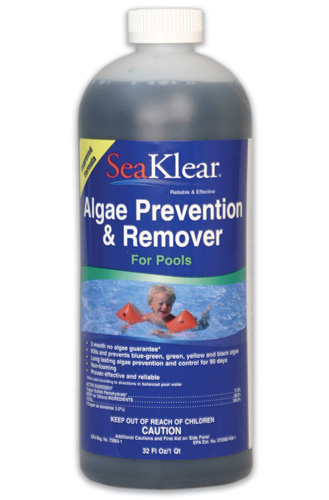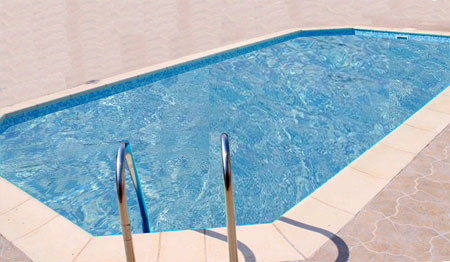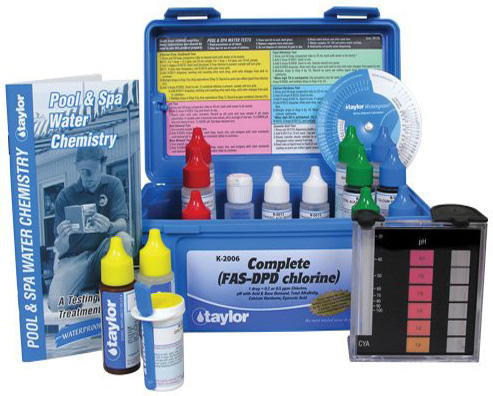The most common question from swimming pool owners are that “how to remove algae from pool water”. Reason, The development of algae is the general problem of them which is noticeable and looks ugly. They are single-celled organisms that grow quickly in the right conditions. Algae are microscopic size; hence they are invisible at naked eye, but visible when they accumulated. By keeping pool chemistry at right stage you can prevent their growth. On the other hand, if we are not able to control them, they will create slime, odor, discolor water etc. Here we discuss about the different types of swimming pool algae and how to prevent algae in pool.

| Table of Contents: |
Types of swimming pool algae
A wide variety species of algae are found in the world. They may be aquatic or non-aquatic. Only few of colors and types of algae are shown in swimming pool. They produce their energy and food by using photosynthesis process. They can be found as free floating, or walls and floor or inside of pipes and filters. The common swimming pool algae are green, black, yellow, pink etc.
Green algae
It is the most familiar among all the swimming pool algae and creates the swimming pool water green cloudy. Lack of proper filtration and sanitation are responsible for development of it. It is very often seen floating on the water and occasionally seen cling to the wall of pool or at the bottom. By brushing, it can be easily free from the wall. Removing green algae from pool is easy by using the accurate amount of shocking, and pool algaecide.
Yellow or mustard algae
The mustard algae look like yellowish green color or brown color. It is seen on the wall or on the bottom of the pool as pollen or sand, where is the lack of sufficient amount of sunlight. When it is started to grow, then it is very difficult to eliminate completely. After elimination, re-infection is common practice. Even treats with normal dose of sanitizer or pool algaecide. They can become chlorine resistant and can exist without sunlight. To kill it you need to use the best pool algaecide and super shocking.
Black algae
Black algae are responsible for stain in the swimming pools walls and floor. They can also become chlorine resistant and can exist without sunlight. It is the most irritating strain of algae. It is extremely hard to remove compare to green or blue-green algae particularly in plastered pools. Even compare to yellow algae. The roots of it are strong and grow deep into the plaster of pool walls. Even if you are taking care and maintenance swimming pool properly. Normally it does not change the clearness of the pool water. The Black algae seem to be as like tiny dark black spots.
Pink algae
Pink algae are not actually algae at all, but is a fungus called Paecilomyces lilacinus that creates slimy white, pink or grey colonies. It is slow to multiply and unusual that it will bloom over the whole swimming pool.
What causes algae in pools
The source of algae may be nearby stream, or a neighbor’s pool. The algae “spores” can dry out in the air and can be carried by the wind. The other sources of swimming pool algae are rain water, swimmer, swimsuits or equipment. If the conditions are in favor of algae bloom, then can occur within 24 hours. The suitable conditions are warm temperatures, sunlight, imbalance water, high pH level, low chlorine (level becomes 0.5 ppm or below) presence of nitrates and carbon dioxide. Organic substance and bacteria can also accelerate the development of algae in pool. July and August are suitable months for growth of swimming pool algae.
Is it safe to swim in a pool with algae?
Algae develop coloration of the water and make it cloudy. Moreover, it reduces the effectiveness of the filter by clogging up the pores. Therefore, it is needed additional backwashing or filter replacement. Swimming pool algae, itself is not dangerous. But it provides nutrients to bacteria (like E-coli) and micro-organisms with the help of sunlight and CO2. Therefore if we are not able to remove algae from pool water then the bacteria increases rapidly and cause disease.
How to prevent algae in pool
Properly swimming pool water maintenance (including regular circulation and filtration) and keeping minimum sanitizer levels will prevent any algae spores entering the pool water. Sufficient amount of free chlorine will help to prevent algae in pool from rising uncontrollable. If it is noticed that algae is growth then it needs treatment. It can be done with chlorine or pool algaecide. You can also remove algae from pool water by scrubbing the brush on the wall or floor where the algae grow. We should not allow blooming the algae in pool water.
Swimming pool algaecide
Algaecide is used to prevent or remove algae from pool water. Most of the pool algaecides are formulated such a way so that it can kill all types of algae. The most common type swimming pool algaecide are copper sulphate, chelated copper-based products, quaternary ammonia, benzalkonium chloride and simazine. It may create water foaming, increasing TDS and change total alkanity and pH. Although copper based algaecide is cheaper, but it is responsible for staining of the pool walls and floor and discolor of the water. So isolated copper based algaecide is recommended, even they are more costly. Quaternary ammonia type algae are fine but it has one problem that it creates foam which is annoying for some people.
Disadvantages of swimming pool algaecide:
- The increase of copper in the sediments
- It may clog the filters.
The swimming pool water should not be operating until the toxins and odors decreases and becomes normal position. Before using the chemicals you should be conform which type of algae is in your pool. It is recommended that, always use rubber gloves, goggles and keeps pool chlorine out of reach of children and pets. If you remove algae from pool water then the swimmers will get a clear and healthy pool to enjoy throughout summer.


